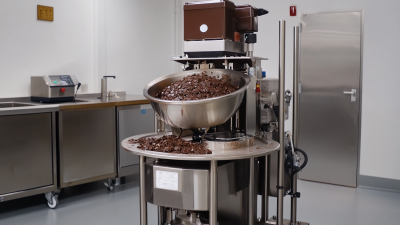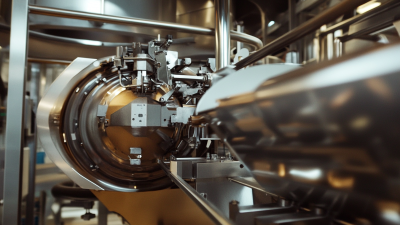How to Choose the Best Chocolate Processing Machine for Your Production Needs
The global chocolate market is anticipated to reach a staggering USD 162.2 billion by 2024, driven by rising consumer demand for premium and artisanal chocolates. As producers strive to meet these evolving tastes and increased production volumes, selecting the best Chocolate Processing Machine becomes crucial in maintaining quality and efficiency.

According to a report by Mordor Intelligence, the chocolate processing machinery market is projected to grow at a CAGR of 6.5% from 2020 to 2025, further highlighting the importance of investing in state-of-the-art processing equipment. When faced with a plethora of options, from continuous conching machines to innovative tempering systems, understanding your specific production needs can make all the difference in meeting market demands while maximizing profitability. In this ultimate guide, we will navigate through the key factors to consider when selecting the perfect chocolate processing machine tailored to your production requirements.
Understanding Your Chocolate Production Requirements
When selecting the optimal chocolate processing machine, understanding your specific production requirements is crucial. The global chocolate market was valued at approximately $136.26 billion in 2022 and is projected to grow significantly, reaching over $189 billion by 2028, according to a recent report by Mordor Intelligence. This indicates an increasing demand for high-quality chocolate products, making efficient production processes essential for manufacturers.
The first step in determining your needs is to analyze your production volume. For instance, small artisanal manufacturers may require machines that can produce 50-100 kg of chocolate per batch, while larger factories may need continuous production lines capable of handling several tons per hour. Additionally, consider the types of chocolate you will be processing—dark, milk, or specialty compounds—as different formulations may require varying machinery specifications. According to a survey by IBISWorld, 65% of chocolate manufacturers reported investing in state-of-the-art machines to enhance efficiency and production capacity, reflecting the significance of aligning your equipment with production goals.
Furthermore, assessing the degree of automation needed is essential. The trend towards automation in chocolate production has been gaining traction, with a report by Grand View Research indicating that the chocolate processing equipment market is projected to witness a CAGR of 5.6% from 2023 to 2030. This growth suggests that investing in advanced machinery can lead to significant cost savings and improved product consistency. Understanding these intricacies of your production requirements will ensure that you choose the best chocolate processing machine that aligns with both your operational goals and market demand.

Key Features to Look for in a Chocolate Processing Machine
When selecting a chocolate processing machine, there are several key features to consider that can significantly enhance your production efficiency and output quality. One crucial aspect is the machine's capacity. According to a report by Mordor Intelligence, the global chocolate market is projected to grow by approximately 4.3% annually, which emphasizes the need for machines that can scale production effectively as demand increases. A machine with a higher capacity will allow manufacturers to meet growing consumer needs without compromising quality.
Another important feature is temperature control. Accurate temperature regulation is vital to maintaining the ideal consistency and texture of chocolate. Machines equipped with advanced temperature monitoring systems ensure that processing conditions remain stable, which is essential for producing high-quality chocolate products. Data from Grand View Research indicates that quality control processes in food manufacturing can reduce wastage by up to 30%.
Tip: Always consider the ease of cleaning and maintenance when choosing a machine. Equipment designed with user-friendly features ensures minimal downtime, ultimately enhancing productivity.
Moreover, look for machines with energy-efficient designs. The chocolate industry can be energy-intensive, so opting for machines that utilize less power can lead to substantial cost savings over time. According to industry analysis, energy-efficient processing equipment can reduce operational costs by as much as 20%.

Comparing Different Types of Chocolate Machines on the Market
When it comes to selecting the best chocolate processing machine, understanding the different types available on the market is crucial. The chocolate production equipment landscape includes various categories such as conching machines, tempering machines, and enrobers, each designed with specific functions that cater to distinct production needs. According to a report by Mordor Intelligence, the global chocolate processing equipment market is expected to grow at a CAGR of 5.6% from 2021 to 2026, driven by rising consumer demand for premium chocolate products.
Conching machines, for instance, are essential for refining chocolate by improving its texture and flavor. They utilize a slow grinding process that allows for better incorporation of cocoa butter and other ingredients, resulting in smoother chocolate.
In contrast, tempering machines stabilize cocoa butter crystals, ensuring that chocolate sets with an appealing shine and snap. Meanwhile, enrobers are integral for coating confections, effectively enveloping centers with a uniform layer of chocolate.
Each machine serves a unique purpose, and understanding these differences can greatly impact the efficiency and quality of chocolate production, making it imperative to choose accordingly based on your specific production goals.
Evaluating Cost vs. Efficiency in Chocolate Production Equipment
When selecting a chocolate processing machine, understanding the balance between cost and efficiency is crucial. According to industry reports, the global chocolate production machinery market is anticipated to grow at a CAGR of 3.6% from 2021 to 2027. This underscores the increasing demand for efficient equipment, as manufacturers seek to enhance productivity while keeping costs manageable.
Tips for evaluating your options include assessing the total lifecycle costs of the machinery. Look beyond the initial purchase price; consider maintenance, energy consumption, and potential downtime. For instance, energy-efficient machines can reduce operational costs by as much as 15% annually, as per a report by the International Journal of Food Engineering. This becomes especially significant for facilities with high production volumes, where even minor savings per unit can lead to substantial overall cost reductions.
Another important consideration is the machine's throughput rate. A more efficient machine can produce 25% more chocolate in the same timeframe, significantly improving output without proportionate increases in labor costs. Additionally, newer technologies, such as automated temperature control and advanced mixing processes, further enhance efficiency, leading to better quality products. Therefore, investing in modern chocolate processing machines can not only optimize production but also yield higher-quality chocolate, satisfying consumer demand for premium products.
Chocolate Processing Machine Cost vs. Efficiency
Maintenance and Support: What to Consider Before Purchasing
When selecting a chocolate processing machine, maintenance and support are crucial factors that can significantly influence your production efficiency and overall satisfaction. An ideal machine should come with a clear maintenance schedule, as regular upkeep is essential to extending the lifespan of your equipment. Always inquire about the availability of spare parts and whether the manufacturer offers comprehensive maintenance services. This consideration ensures that you can quickly address any potential issues without causing significant downtime in your production line.
Tip: Look for machines that provide user-friendly manuals and online resources. This can ease the maintenance process and help your team troubleshoot minor issues independently.
Additionally, consider the level of customer support that the manufacturer offers. Reliable customer support can make a world of difference, especially when you're facing urgent operational challenges. Ensure that they provide multiple contact options, such as phone, email, or live chat, and verify their response times.
Tip: Read reviews from other customers regarding their experiences with the manufacturer’s support services. Positive feedback could indicate a trustworthy partnership.
Related Posts
-

Experience Unmatched Chocolate Quality with Our Advanced Conching Machine
-

Maximizing Value with Exceptional Support and Maintenance Cost Efficiency in Chocolate Processing Machines
-

Understanding Global Industry Standards for the Best Chocolate Cutting Machine: A Purchasing Guide
-

What Makes the Best Chocolate Manufacturing Machine Essential for Your Business
-

Understanding the Essential Specifications of Chocolate Tempering Equipment for Global Buyers
-

Essential Tips for Sourcing High-Quality Commercial Chocolate Production Equipment
